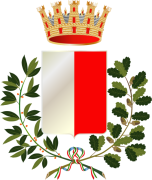 Panzerotti. From Bari. These are one of the most famous and popular dishes from Bari. They are deep fried pockets of dough stuffed with a variety of fillings. Two of the most common are mozzarella, cherry tomatoes and oregano and ricotta forte (also called skuanda), cherry tomatoes, onion and anchovies. Ricotta forte is a bit of a “Marmite” ingredient. By that I mean it is very strongly flavoured and you either love it or hate it. I am in the first camp, lovely stuff. Rather than cherry tomatoes, “appesi” are more traditional. These are small tomatoes which are picked when still not completely ripe and hung up for later consumption. As these are hard to find, you can use any type. I went to a party here and a lady was employed just to make panzerotti all evening. The last round was filled with Nutella! The size of the panzerotti varies, but I made 12 with this recipe.
Panzerotti. From Bari. These are one of the most famous and popular dishes from Bari. They are deep fried pockets of dough stuffed with a variety of fillings. Two of the most common are mozzarella, cherry tomatoes and oregano and ricotta forte (also called skuanda), cherry tomatoes, onion and anchovies. Ricotta forte is a bit of a “Marmite” ingredient. By that I mean it is very strongly flavoured and you either love it or hate it. I am in the first camp, lovely stuff. Rather than cherry tomatoes, “appesi” are more traditional. These are small tomatoes which are picked when still not completely ripe and hung up for later consumption. As these are hard to find, you can use any type. I went to a party here and a lady was employed just to make panzerotti all evening. The last round was filled with Nutella! The size of the panzerotti varies, but I made 12 with this recipe.

Panzerotti ingredients
For the pastry
- 500 g 00 flour
- 100 ml tepid milk
- 1 cube of fresh yeast
- 2 tablespoons of olive oil
- 10 g salt
Dissolve the yeast in the milk. Add the milk to the flour, oil and salt along with enough tepid water to make a smooth dough.
Oil the dough, cover with a tea towel and leave to rise for up to 2 hours.
Separate the dough into 12 portions and roll into small balls. Cover with a tea towel and leave to rise for a further half an hour.

Panzerotti balls of dough
Take one ball of dough and roll it into a large disc. Place a large tablespoon of filling in the middle of each one. Fold the dough over to form a half moon shape. Press down well and try to exclude as much air as possible. Either fold over and crimp the edges or cut off the excess pastry with a pasty wheel and seal the edges with a fork.
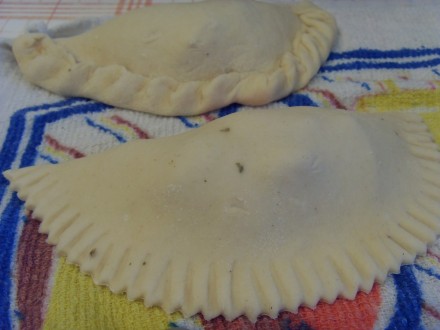
Panzerotti ready to cook
Deep fry the panzerotti until they are lightly golden. Some people use extra virgin olive oil and some people use regular vegetable oil. You can also bake them in an oven at 200 °C for 15 minutes, but the result is quite different.
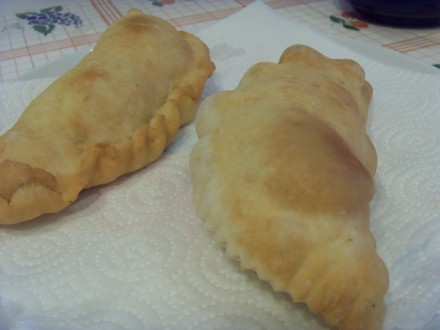
Panzerotti finished dish
Fillings
- 200 g mozzarella
- 300 g cherry tomatoes
- Oregano
- Chop and drain the tomatoes. Cube the mozzarella. Mix together with a generous amount of mozzarella.
- 50 g ricotta forte
- 100 g cherry tomatoes
- 50 g onions
- An anchovy
- Salt and pepper.
- Fry the onion in some oil, bone and chop anchovy. Spread each disc of dough with ricotta forte. Add a piece of tomato, some onion and a piece of anchovy. Salt and pepper to taste.
- 100 g ricotta forte
- 20 g grated pecorino romano
- 2 cherry tomatoes for each panzerotto
- 1 egg yolk (optional)
- Mix together the ricotta forte and the pecorino. Some people like to add an egg yolk to the mixture. Place a tablespoon of the filling and 2 chopped tomatoes in each panzerotto.
- Radicchio and gorgonzola.
- Fried minced pork mixed with parmsan and mozzarella. This is traditional on shrove Tuesday.
And of course the very untraditional but popular with children young and old:-
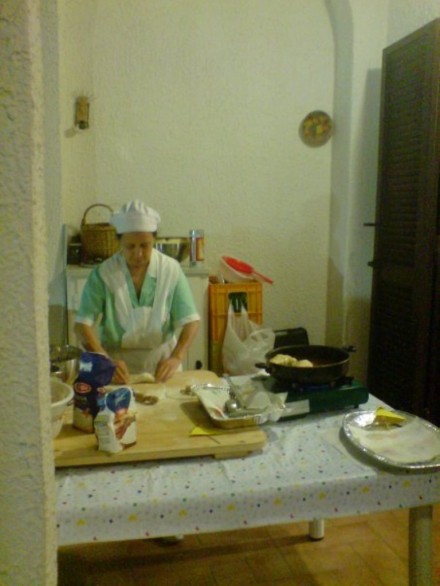
Peppina at the party
0.000000
0.000000

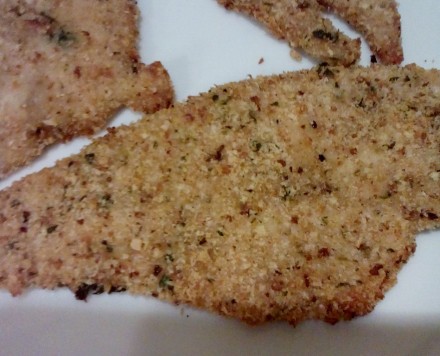
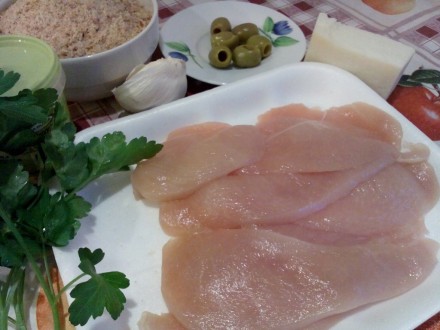

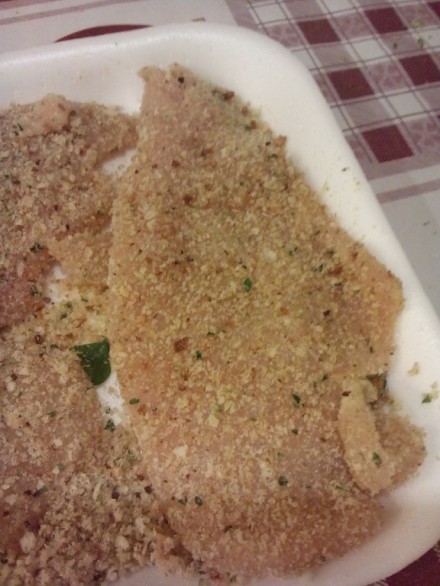




























 Basil is very much in season here at the moment, so I bought a couple of bunches at the market and decided to make pesto.I dug out the official recipe from Consorzio Pesto Genovese. It’s very specific about exactly where the ingredients should come from. I’m providing the original recipe, but feel free to substitute ingredients from another region. eg. Basil not from Genoa 🙂 The recipe also calls for a pestle and mortar. This is undoubtably the best way, but you can get very acceptable results using a blender. Just put all the ingredients in a blender and blitz until almost smooth. Serves 6
Basil is very much in season here at the moment, so I bought a couple of bunches at the market and decided to make pesto.I dug out the official recipe from Consorzio Pesto Genovese. It’s very specific about exactly where the ingredients should come from. I’m providing the original recipe, but feel free to substitute ingredients from another region. eg. Basil not from Genoa 🙂 The recipe also calls for a pestle and mortar. This is undoubtably the best way, but you can get very acceptable results using a blender. Just put all the ingredients in a blender and blitz until almost smooth. Serves 6

 Alici arraganate. From Puglia. There is probably not much chance of finding fresh anchovies in the UK, but if you do, this is a good recipe to try. It takes a fair bit of preparation, but it’s worth it in the end. You need to clean them as soon as you get them home as they will spoil extremely quickly. Do not do as I did this morning and leave yourself 30 minutes to clean a couple of hundred anchovies before you have to go to work 🙂 To clean them, snap the back bone just behind the head and pull. The guts should come out with the head. If you can’t get the hang of that, use a small sharp knife to cut through the back bone, taking care not to cut all the way through and pull. Next remove the backbone by running your thumb along the spine of the fish, flattening it out into two fillets. The backbone should then be easy to pull out. “Close” the fillets by folding them along the line of the backbone. The recipe says this will feed 4 as an antipasto, but it would feed at least that number as a British style starter.
Alici arraganate. From Puglia. There is probably not much chance of finding fresh anchovies in the UK, but if you do, this is a good recipe to try. It takes a fair bit of preparation, but it’s worth it in the end. You need to clean them as soon as you get them home as they will spoil extremely quickly. Do not do as I did this morning and leave yourself 30 minutes to clean a couple of hundred anchovies before you have to go to work 🙂 To clean them, snap the back bone just behind the head and pull. The guts should come out with the head. If you can’t get the hang of that, use a small sharp knife to cut through the back bone, taking care not to cut all the way through and pull. Next remove the backbone by running your thumb along the spine of the fish, flattening it out into two fillets. The backbone should then be easy to pull out. “Close” the fillets by folding them along the line of the backbone. The recipe says this will feed 4 as an antipasto, but it would feed at least that number as a British style starter.



 Polpettone alla napoletana. This is a tasty and economical recipe. In Naples it is also known as ‘polpettone in salsetta’ – meatloaf in sauce. The sauce is used to dress pasta for the first course and the meat is eaten as the second course. The recipe calls for buffalo mozzarella and Neapolitan salami, but I’m sure it would be fine with whatever you have handy. Thank to Gino for the advice. Serves 4-6.
Polpettone alla napoletana. This is a tasty and economical recipe. In Naples it is also known as ‘polpettone in salsetta’ – meatloaf in sauce. The sauce is used to dress pasta for the first course and the meat is eaten as the second course. The recipe calls for buffalo mozzarella and Neapolitan salami, but I’m sure it would be fine with whatever you have handy. Thank to Gino for the advice. Serves 4-6.









 From Lazio. What is Carbonara? If You ask an Englishman they’ll probably tell you it’s a dish prepared with cream and ham! Nooooooo!!!!! 😉 More crimes against Italian food have been committed under the name of Carbonara than any other dish.
From Lazio. What is Carbonara? If You ask an Englishman they’ll probably tell you it’s a dish prepared with cream and ham! Nooooooo!!!!! 😉 More crimes against Italian food have been committed under the name of Carbonara than any other dish.




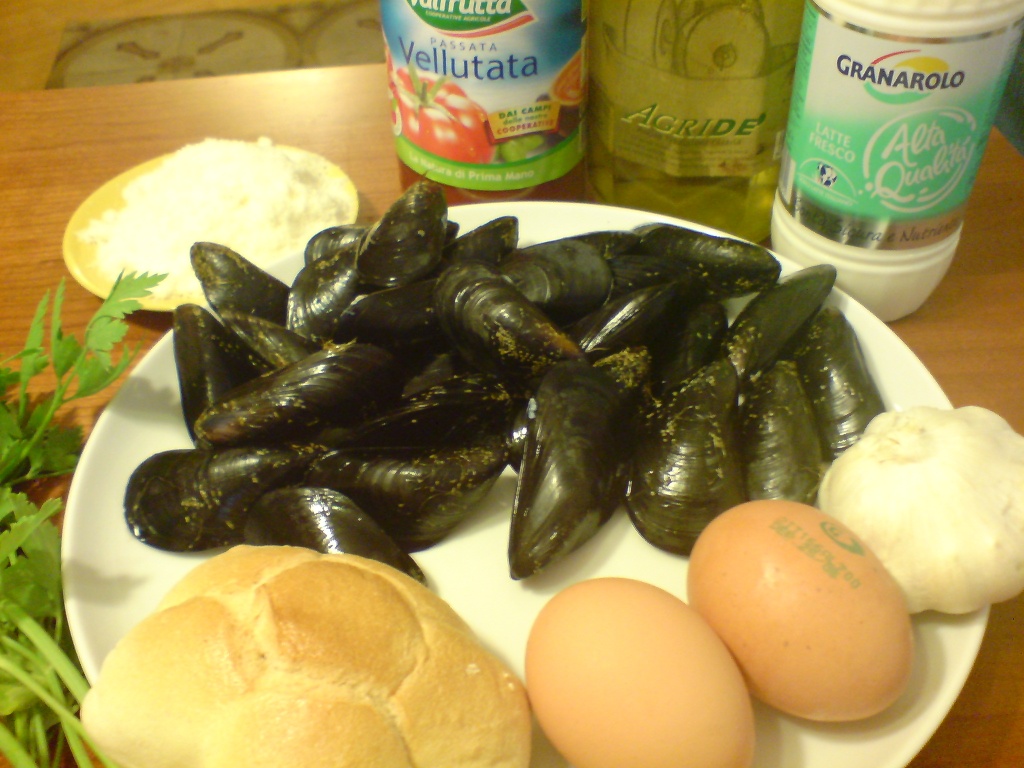
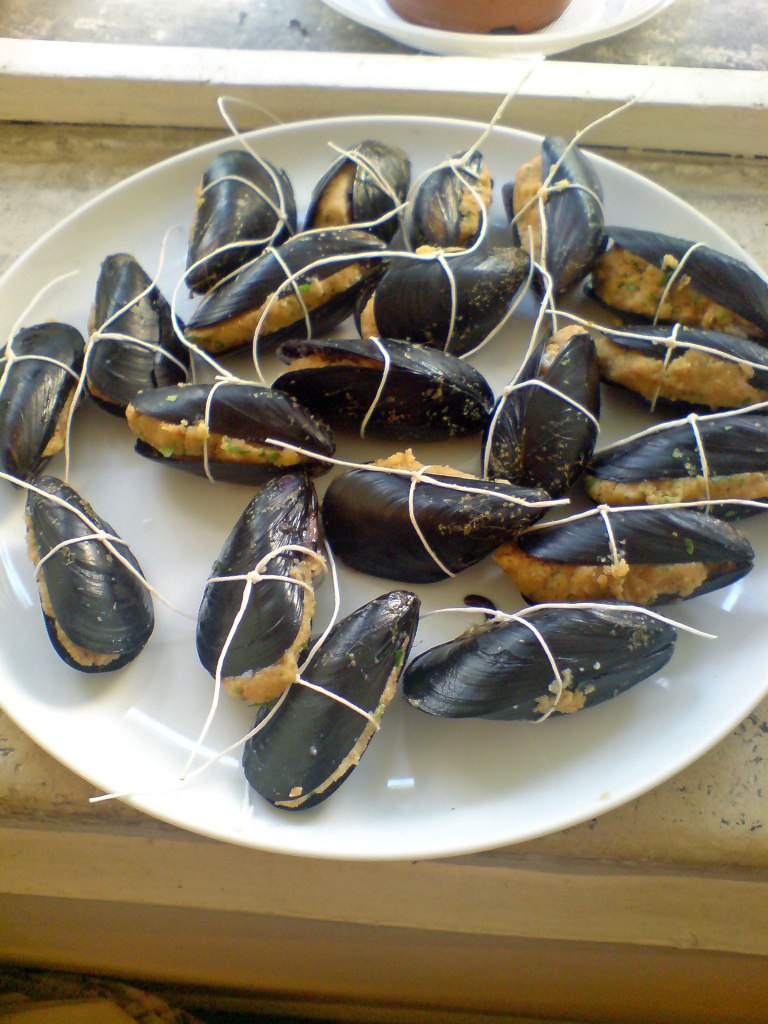
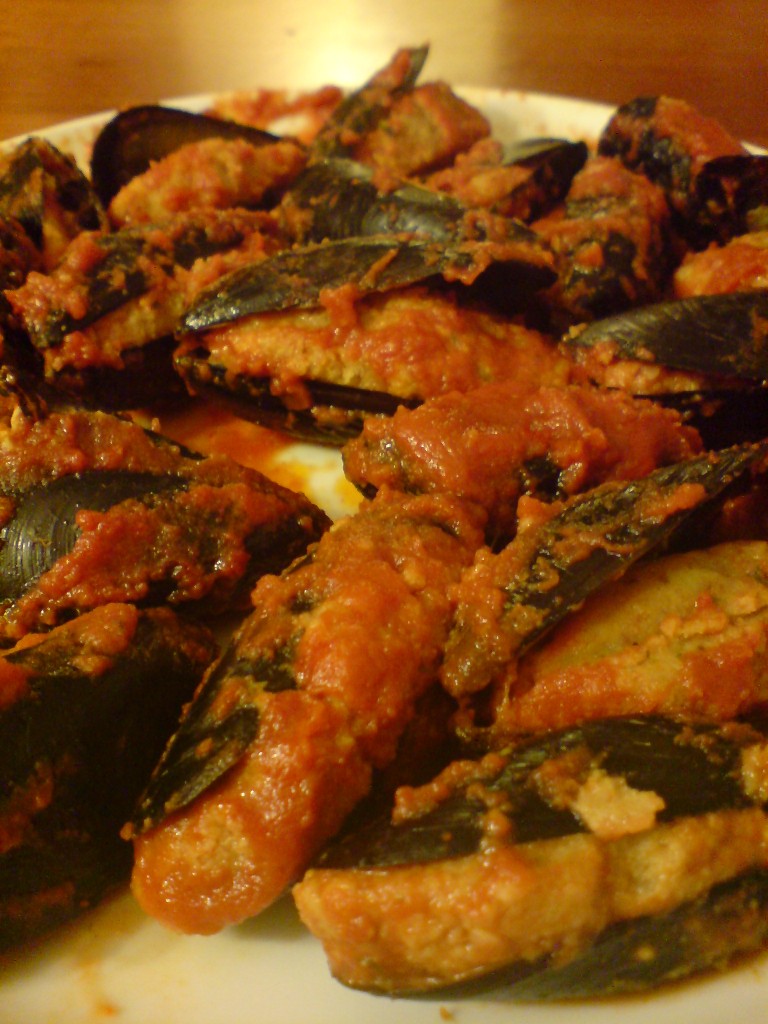
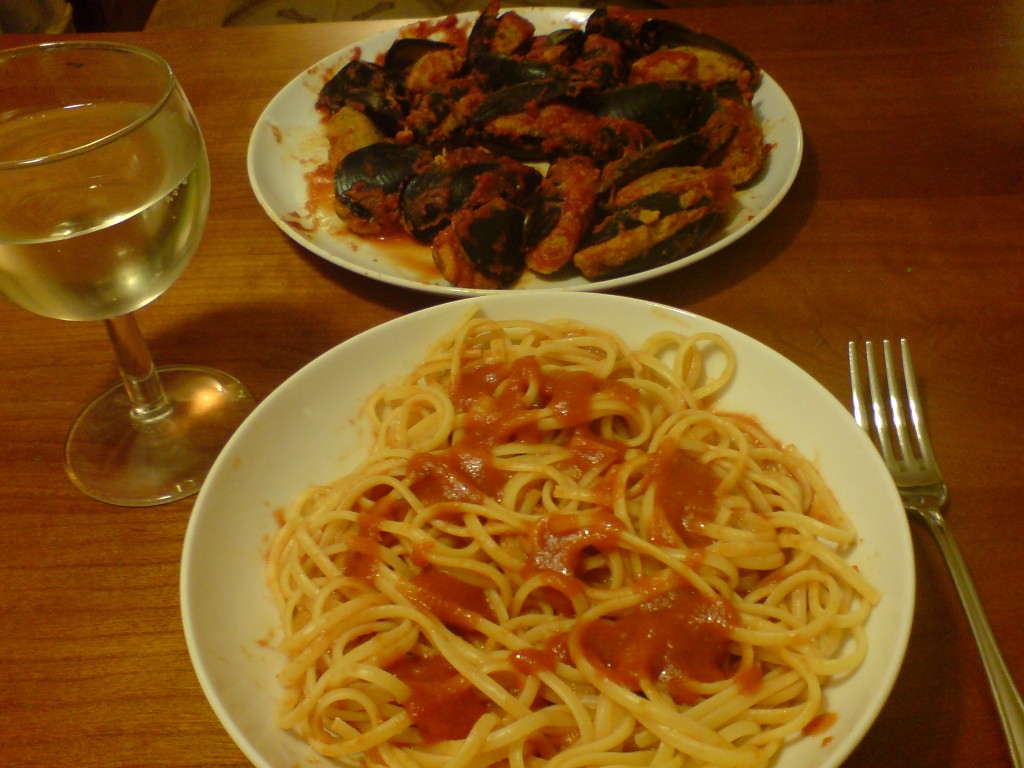
 This is another recipe from Tiziana (many thanks). This one of the most common ‘Sunday lunches’ in Bari. I think it’s known as “Sunday gravy” in the Sates. The recipe doesn’t give very precise measurements as it depends how many people you are cooking for and your personal taste. As a rough guide allow 2-300g of meat per person. Tiziana usually serves the ragu with orecchiette, but you can use your favourite pasta. Serve the meat separately as the second course.
This is another recipe from Tiziana (many thanks). This one of the most common ‘Sunday lunches’ in Bari. I think it’s known as “Sunday gravy” in the Sates. The recipe doesn’t give very precise measurements as it depends how many people you are cooking for and your personal taste. As a rough guide allow 2-300g of meat per person. Tiziana usually serves the ragu with orecchiette, but you can use your favourite pasta. Serve the meat separately as the second course.

